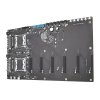Check the temps on your plx switches; The board was meant for high-airflow.Two of the GPUs will randomly drop after some random amount of time
It was built&design for constant airflow with plx below 80'C - and likely has 100-110'C max before shutdown .
(plx chips have aluminum heatsinks on them - check if you are loosing plx chips running lspci when it happens - if that's the case - it means they are shutting down due to heat)
if you have had pcie errors from the pcie links you would see plenty msgs in your system logs about it.
In terms of LED's i'm not sure, i never paid attention | server was closed before it was powered on.
Last edited:


